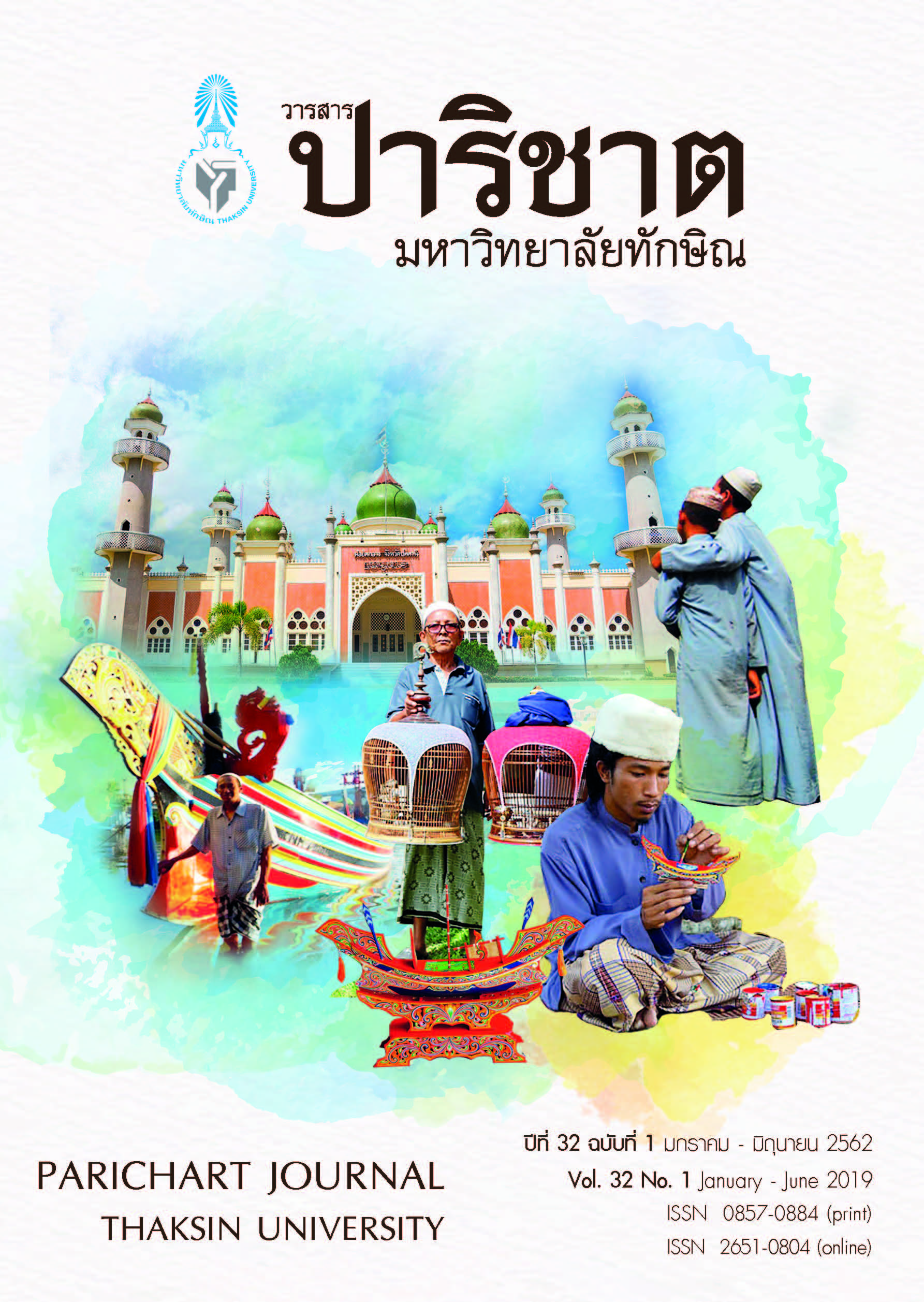Human Resource Development in Organizations to Innovative Organization in the Era of Thailand 4.0
Main Article Content
Abstract
Nowadays business competition is directed towards product innovation and innovative in procedures coupled with stressing low costs but high profits. This process is the development of those with
cognitive powers whereby organizations will utilize knowledge, skills, and creativity in developing value-added products and services to enhance competitive business advantage in consonance with labor skill standard of personnel development to accommodate the movement towards the realization of Thailand 4.0. This change in economic structure combines mobilizing creativity and innovative technology with the
development of high value services. The change involves moving from a condition of labor with low-level skills to a condition of highly-skilled labor displaying knowledge and expertise. The advent of innovative
products and innovative procedures requires taking into consideration marketing, technology, and employment factors. All of these directly and unavoidably affect the economic environment. In order to expand business, businesses must make adjustments, so that knowledgeable and competent personnel can pave the way to advancement. Economic growth depends on a window of opportunity in the aspect of management. This is considered a challenge to organizations in the aspects of fostering innovation, developing human capital, building relationships with customers, while operationally emphasizing excellence and the building of business sustainability.
Article Details
References
Swanson, R. A., & Holton, III. Elwood, F. (2008). Foundations of human resource development. California: Berrett-Koehler Publishers, Inc.
Setyawati, S. M., Rosiana, M., & Shariff, M. N. M. (2017). Competitive advantage as mediating variable on the relationship between innovation and business performance on SMES in Purwokerto Province. Saudi Journal of Business and Management Studies, 2(7), 693-699.
Girotra, K., & Netessine, S. (2014). Four paths to business model innovation. Harvard Business Review. 92(7), 96-103.
Office of the Civil Service Commission (OCSC). (2016). Thailand in the context of Thailand 4 .0 under Constitution of The Kingdom of Thailand 2017. Bangkok: Office of the Civil Service Commission (OCSC). (In Thai)
Teanravisitsagool, P. (2016). Prep-course in human resources management in the context of Thailand 4.0 under New Draft Constitution of the Kingdom of Thailand. Bangkok: Office of the Civil Service Commission (OCSC). (In Thai)
Kusumavalee, S. (2016). HR 4.0 trends and move@ Thailand 4.0. HR Society Magazine, 14(164), 36-39.
Buanoi, D. (2016). Innovation and creativity. Journal of Management and Marketing, 3(1), 1-12. (In Thai)
Aujirapongpan, S., Vadhanasindhu, P., Chandrachai, A., & Cooparat, P. (2010). Innovation: Capability of the entrepreneurs. Journal of Business Administration, 33(128), 49-65. (In Thai)
McKeown, M. (2008). The truth about innovation. London: Prentice Hall.
Schilling, M. A. (2008). Strategic management of technological innovation. (2nd Ed.). NY: McGraw-Hill Education.
Solberg, S. K., & Tontini, G. (2013). Knowledge management system and human resource management policies for innovation benchmarking: A study of ST Ericsson. Journal of International Journal of Innovation Science, 5(3), 159-169.
Kaplan, S. (2012). The business model innovation factory: How to stay relevant when the world is changing. New Jersey: Wiley & Sons.
Fatemeh, N., Mohammad, H., Zolghadr S., & Ali, Z. S. (2017). Organizational knowledge documentation in project-based institutes. Electronic Library, 35(5), 994-1012.
Stefano, B., & Antonino, V. (2017). Ethics, technology and organizational innovation. Journal of Business Ethics, 143(2), 223-226.
Quaddus, M. A., & Woodside, A. G. (2015). Sustaining competitive advantage via business intelligence, knowledge management, and system dynamics. Bingley, UK: Emerald Group Publishing Limited.
Maggie, F. (2017). Leadership reflections: leadership skills for knowledge management. Journal of Library Administration, 57(6), 674-682.
Loewe, P., & Chen, G. (2007). Changing your company’s approach to innovation. Strategy & Leadership. 35(6), 18-26. Retrieved from https://doi.org/10.1108/10878570710833723. on 7 November 2017.
Inauen, M., & Schenker, W. A. (2012). Fostering radical innovations with open innovation. European Journal of Innovation Management, 15(2), 212-231. Retrieved from https://doi.org/10.1108/14601061211220986. on 7 November 2017.
Chandra, M., & Neelankavil, J. P. (2008). Product development and innovation for developing countries: potential and challenges. Journal of Management Development, 27(10), 1017-1025.
Eisingerich, A. B., Bell, S., & Tracey, P. (2010). How can clusters sustain performance? The role of network openness, and environmental uncertainty. Research Policy, 39(2), 239-253.
Whelan, E., Parise, S., de Valk, J., & Aalbers, H. L. (2011). Creating employee networks that can deliver open innovation. MIT Sloan Management Review, 53(1), 37-44.
Sabir, R. I., & Sabir, R. M. (2010). Managing technological innovation: China’s strategy and challenges. Journal of Technology Management in China, 5(3), 213-226.
Gailly, B. (2011). Developing innovative organizations: A roadmap to boost your innovation potential. U.K.: Palgrave Macmillan.
Sariol, A. M., & Abebe, M. A. (2017). The influence of CEO power on explorative and exploitative organizational innovation. Journal of Business Research, 73, 38-45.
Aalbers, R., & Dolfsma, W. (2014). Innovation despite reorganization. Journal of Business Strategy, 35(3), 18- 25.
Morten, B. H., & Norup, I. (2017). Leading the implementation of ICT innovations. Public Administration Review, 77(6), 851-860.
Sabanovic, A., & Solberg S. K. (2012). Customers’ expectations and needs in the business intelligence software market. Journal of Intelligence Studies in Business, 2(1), 29-40.
8] Salopek, J. J. (2013). The very BEST learning organization of 2013. Talent Development, 67(10), 34-82.
9] Hamel, G., & Breen, B. (2009). The future of management. Boston, MA.: Harvard Business School Press.
Senge, P. M. (2006). The fifth discipline: The art and practice of the learning organization. USA: Doubleday.
Marquardt, M. J. (2017). Building the learning organization for human resource development among ASEAN countries. In National Conference Faculty of Human Resource Development. Ramkhamhaeng University, April 3, 2017, 16-42.
Aujirapongpan, S., Vadhanasindhu, P., Chandrachai, A., & Cooparat, P. (2011). Knowledge management capability and innovativeness of innovation entrepreneurs in Thailand. Nida Development Journal, 51(1), 157-199. (In Thai)
Ahmed, P. K. (2010). Innovation management: Context, strategic, system and process. U.K.: Pearson Education.
Nonaka, I., & Takeuchi, H. (1995). The knowledge-creating company: How Japanese companies create the dynamics of innovation. New York: Oxford University Press.
Gobbo, J. A. Jr., & Olsson, A. (2010). The transformation between exploration and exploitation applied to inventors of packaging innovations. Technovation, 30(5), 322-331.


